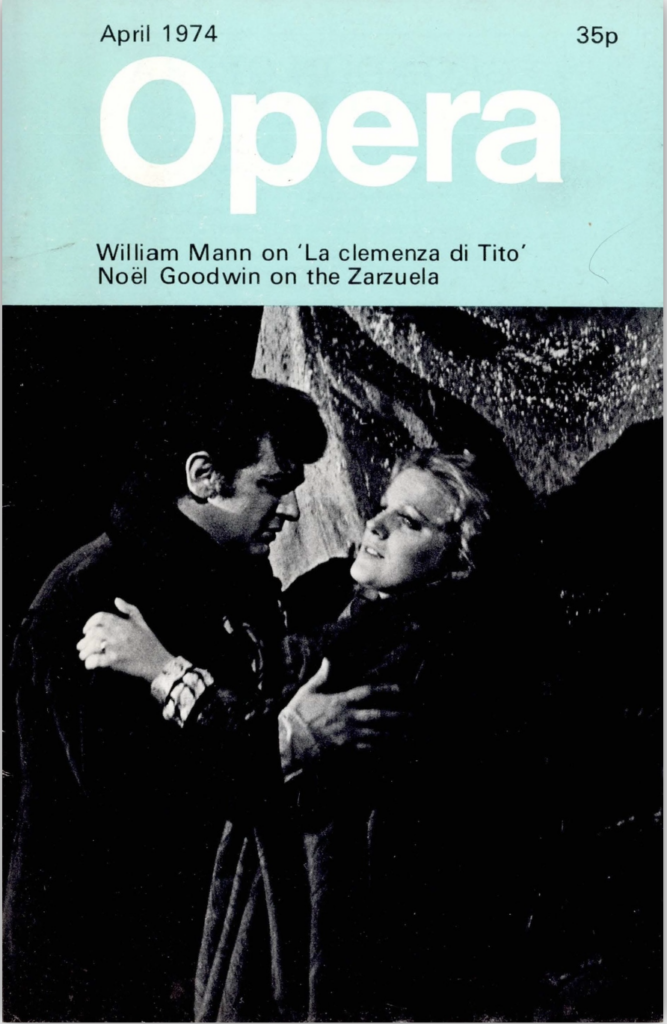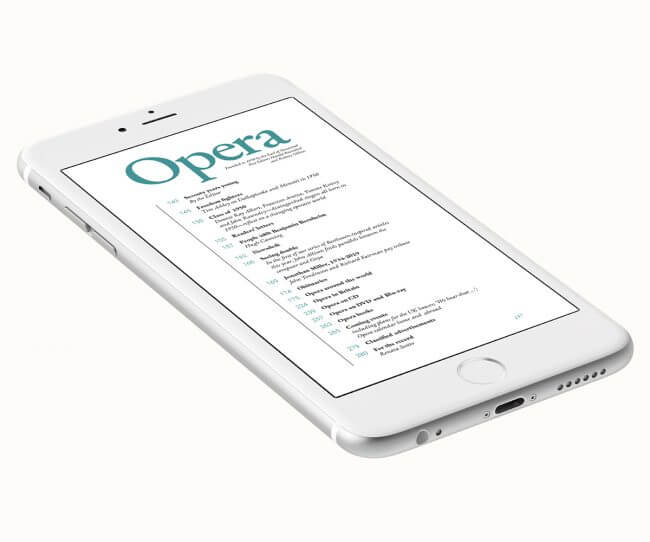Barbara Hannigan
December 2019 in People
By Andrew Clements
In March 1998, opera’s review of a production of Gluck’s Orpheus and Eurydice by Opera Atelier in Toronto mentioned an Amor sung with ‘fresh tone’ that was ‘well suited’ to the role. That was the first mention of Barbara Hannigan in these pages. The following year she was noted as ‘singing brightly and moving with a dancer’s teasing skill’ in the roles of Alinda and Cupid in Cavalli’s Giasone, this time for the Canadian Opera Company (March 1999, pp. 314-15). Yet by then Hannigan was already beginning to establish herself in the specialist repertoire in which she would go on to win an international reputation for the flexibility and accuracy of her high soprano. Her transition from early opera to 20th- and 21st-century repertoire proceeded rapidly, first with the role of Saskia de Vries—the girl with the pearl earring—in Louis Andriessen’s Writing to Vermeer at its 1999 premiere in Amsterdam, and then, back in Canada, in Claude Vivier’s Kopernikus.
Hannigan was then in her late 20s. She had grown up in Halifax, Nova Scotia, where she sang at home and at summer camps from childhood, but where opportunities to hear contemporary music were limited. There was, though, the annual Scotia Festival, which was visited by conductors including Pierre Boulez and Oliver Knussen. At the age of 17 she left Halifax for Toronto to finish high school at a performing arts academy, and then went on to study music at the city’s university, where she linked up with the singing teacher Mary Morrison, with whom she would work for the next ten years. She was soon giving her first premiere, when a fellow student wrote a set of songs for her to perform in her graduation recital. Morrison had quickly realized where Hannigan’s interests lay and encouraged her to explore whatever music she could find. ‘Everything was new for me,’ Hannigan remembers. ‘Bruckner and Mahler were new to me, Ligeti was new. When I got to Toronto I just went to everything I could—both early music and modern music. I didn’t see the modern music as separate, because I didn’t know.
‘I used to sit in the aisle of the library and pull out scores and think, “Why am I interested in this and not in this?”, listening to recordings and going to concerts all the time. I ended up singing in the series of modern-music concerts that the flautist Robert Aitken organized in Toronto; it was a concert of music by Henry Brant, I was 19 years old and somehow my first professional performance ended up on a CD, my first recording. It was not a difficult piece and I had those crazy high notes, higher than I have today. I was also singing the Queen of the Night and a lot of Handel oratorios as well, but I had this passion for modern music and I looked around and saw that no one else had that passion.’
After graduating and spending a year at the Banff Centre for Arts and Creativity, Hannigan came to Europe, at the age of 23. She first spent a year in London, ‘which wasn’t my bag—because I sang contemporary music, the singing teachers there wouldn’t hear me’. Instead she joined the opera class at the Hague Conservatory, where she sang the title role in The Cunning Little Vixen with Kenneth Montgomery conducting. That attracted the attention of the Schoenberg and ASKO Ensembles, and the composer Louis Andriessen, and while still at the Conservatory she landed the role of the model in Writing to Vermeer, conducted by Reinbert de Leeuw.
At first she still divided her time between Canada and Europe, but as her career burgeoned Hannigan eventually decided to settle on this side of the Atlantic. There were concerts with Pierre Boulez (Pli selon pli) and Oliver Knussen (both Where the Wild Things Are and Higglety Pigglety Pop!) and a steadily accumulating list of opera engagements including Michel van der Aa’s monodrama One and the role of Gabriele in the first staging of Gerald Barry’s The Bitter Tears of Petra von Kant at English National Opera in 2005, in Richard Jones’s production. That was the start of a continuing collaboration with Barry, who went on to compose the one-act La Plus Forte for her, as well as the title role in Alice’s Adventures Underground, with a further work in the pipeline.
Although Hannigan insists that there was never a time when she concentrated exclusively on either concerts or opera, the latter did gradually begin to feature more prominently in her schedule. The role of Her in the Aix premiere of Passion, Pascal Dusapin’s reworking of the Orpheus myth, followed in 2008, but it was not until 2010 that she first sang the coloratura role of the Chief of Police in Ligeti’s Le Grand Macabre,in the production by La Fura dels Baus, though by then the concert scena extracted from the role, Mysteries of the Macabre, had already become one of her signature pieces.
But it was 2012 that marked the real turning point in her operatic career, when she followed up the premiere of George Benjamin’s Written on Skin at the Aix-en-Provence Festival with the title role in Krzysztof Warlikowski’s production of Lulu in Brussels. ‘Written on Skin was a game-changer for me, for two reasons—for George’s music and working with Katie Mitchell. And then Lulu was
a game-changer because of Warlikowski.’ Doing the two operas back to back was revealing in itself. Agnès, her character in Benjamin’s opera, is, she says, a kind of ‘pre-Lulu’, an intelligent woman who cannot express what she feels because of the constraints of medieval society, whereas ‘Lulu knows exactly who she is; she trusts herself emotionally and intellectually, she’s a mirror for so many people that she upsets them. I haven’t seen evidence that she manipulates anyone.’
But enigmatic women have become Hannigan’s stock-in-trade; since Agnès and Lulu there has been Mélisande in productions by Mitchell at Aix and by Warlikowski at the Ruhr Triennale, and Marie in Die Soldaten in Munich. In preparing such roles she tries not to come to rehearsals with any preconceptions. ‘I only look at the scores. I didn’t read the Maeterlinck and the Wedekind, only what Debussy and Berg included in their librettos. If I wasn’t on stage I didn’t want to know what the other characters were saying about me, or the way in which Pelléas relates to Golaud. Mélisande couldn’t process that information.
‘Whereas I think Lulu is telling the truth most of the time, in Mélisande’s case you don’t know whether she’s telling the truth or lying all the time. Her brain is functioning somewhere outside of herself, it’s almost that she’s incapable of answering questions. It’s true when she says “Je ne sais pas”. But she does often lie because it’s a protective mechanism; the truth for her is “must protect Mélisande”. She knows that Golaud has some anger issues, and there are all those other unanswered questions in Pelléas—“Where is the father upstairs? What happened to Golaud’s mother? What happened to his first wife? Who killed her?”’ The Soldaten Marie is another thing altogether. ‘I like to think that the Marie who survives in Soldaten then meets Wozzeck, and has the child with him. I don’t think I will ever sing Wozzeck, though, it’s too heavy for me. I have done the Three Pieces in concert and felt I had to recover afterwards, whereas the Soldaten Marie is Webernesque, very high pointillistic writing.’
Andreas Kriegenburg, who directed the Munich Soldaten and is also directing the first English-language staging of Hans Abrahamsen’s The Snow Queen in Munich this month, in which she sings the role of Gerda, is one of the three directors in her pantheon of collaborators, along with Warlikowski and Mitchell. ‘By the time you get to opening night with Katie,’ she says, ‘she has created such a dramaturgical line through the piece that you cannot go AWOL, which is fine if you have any divas in the cast, as they can’t go in any other way, partly because of that line and partly because of the backstory she has created.’
A pet peeve is that ‘a lot of opera conductors don’t turn up for music rehearsals, but leave them to assistants. But except when he was rehearsing the orchestra Kirill Petrenko was always in the Soldaten rehearsals; and at Glyndebourne too, for Brett Dean’s Hamlet, Vladimir Jurowski was always there—even when he wasn’t actually taking the rehearsal he would be sitting at the side marking his score.’ How conductors behave clearly matters a great deal to her, especially as her own conducting career now occupies a larger and larger part of her work. When we met she was in Snape, as one of the Artists in Residence at this year’s Aldeburgh Festival, where she was appearing both as a singer, giving a recital of Satie with Reinbert de Leeuw as her partner, and as a conductor for three concerts with the Dutch-based Ludwig Orchestra. They included a concert performance of The Rake’s Progress, the first opera she’s tackled, with a cast from her own Equilibrium Young Artists programme, which brings together singers from all over the world.
‘Conducting hadn’t really entered my mind until about 2007, when someone suggested that I sing and conduct Mysteries of the Macabre. So I did it in a programme with Stravinsky’s Renard, and afterward I felt that it was something that I’d like to explore further. I kept it quiet for a while, but had some lessons with Jorma Panula and after that both David Zinman and Simon Rattle helped me a lot. Now this season it’s been about 65 per cent conducting, next year it’s around 50-50, and I have orchestras with whom I have regular relationships—the Munich Philharmonic, Gothenburg and Radio France. I never do exclusively contemporary music—I think it’s too difficult for the brain, I much prefer a programme that has a dramaturgical thread, which is tied together not by when the pieces were written but by some other link. So in Munich recently I did a Hungarian programme of Bartók, Haydn, Ligeti and Kurtág, while another was Schoenberg’s Friede auf Erden, the Berg Violin Concerto and Mozart’s Requiem.’ Her programming was also on show at this year’s Ojai Music Festival, of which she was music director.
That will be the future, you sense. But as well as Gerda in The Snow Queen, a role that Abrahamsen conceived for Hannigan after she gave the premiere of his exquisite Grawemeyer Award-winning song cycle Let Me Tell You in 2013, there are still a few opera roles she would like to take on. Erwartung is on the cards—‘I’ll sing it first in concert with Simon and then do it on stage with Warlikowski’—as well as a return to some of her previous successes: Lulus through to 2021 and Agnès in Written on Skin, ‘once more for George’. But she doesn’t want to sing Soldaten again ‘because I’ll only be disappointed’, and both the productions of Pelléas were so satisfying she sees no need to revisit them either. Isabel, the king’s wife in Benjamin’s second opera for Covent Garden, Lessons in Love and Violence, is another role she won’t repeat—‘It was fun to act, but vocally it was not satisfying in the way that Written on Skin is; there’s no catharsis, it would have been better if she had been killed at the end’—while there are ‘plenty of other singers’ who could sing the role of Ophelia in Dean’s Hamlet. In other words, we should treasure Hannigan’s stage performances while we still can.









